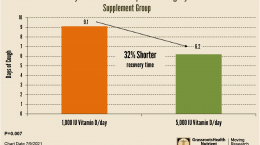Published on November 30, 2023
Congratulations and Thanks to the Target-D Trial for demonstrating the importance of dosing based on serum level!
Key Points
- Findings from the Target-D trial showed that participants needed much more vitamin D than what is currently recommended and used in other large vitamin D trials that utilize a ‘single dose for all participants’ study design
- For example, the VITAL trial implemented a ‘give all one dose’ protocol, where their vitamin D group received only 2000 IU vitamin D per day, and findings from that study were based on that single dose; in the Target-D trial, only 1 in 10 could achieve a vitamin D level of at least 40 ng/ml using a dose of 2000 IU per day
- “We need to be far more intentional in how we’re treating patients with Vitamin D beyond just telling them to take a vitamin pill.”
 The Target-D trial has been receiving well-deserved media attention over the last few weeks. The trial, which included 632 acute coronary syndrome (ACS) patients, was designed to dose vitamin D according to an achieved 25(OH)D serum level with a target of at least 40 ng/ml (100 nmol/L). Their findings showed that participants needed much more vitamin D than what is currently recommended and used in other large vitamin D trials that utilize a ‘single dose for all participants’ study design.
The Target-D trial has been receiving well-deserved media attention over the last few weeks. The trial, which included 632 acute coronary syndrome (ACS) patients, was designed to dose vitamin D according to an achieved 25(OH)D serum level with a target of at least 40 ng/ml (100 nmol/L). Their findings showed that participants needed much more vitamin D than what is currently recommended and used in other large vitamin D trials that utilize a ‘single dose for all participants’ study design.
One recent example, the VITAL trial, implemented a ‘give all one dose’ protocol, where their vitamin D group received only 2000 IU vitamin D per day, and findings from that study were based on that single dose. In the Target-D trial, only 1 in 10 could achieve a vitamin D level of at least 40 ng/ml using a dose of 2000 IU per day… thus a majority of those in the VITAL trial’s vitamin D group likely remained vitamin D deficient or insufficient – how well can findings using such a study protocol be trusted?
How Did the Target-D Trial Dose Participants?
Dosing of participants in the Target-D trial was based on each individual’s starting 25(OH)D serum level. For those starting off with a vitamin D level of at least 40 ng/ml, no additional vitamin D was given. For those below 40 ng/ml:
- 1000 IU/day was given to those with a baseline vitamin D level of 36-40 ng/ml
- 2000 IU/day was given to those with a baseline level of 31-35 ng/ml
- 3000 IU/day was given to those with a baseline level of 26-30 ng/ml
- 5000 IU/day was given to those with a baseline level of 25 ng/ml or lower
The dose was doubled if, after 3 months of supplementation, a vitamin D level was still below 40 ng/ml. The trial found that 86.5% of participants required a vitamin D dose greater than 2000 IU per day; 14.6% of participants needed more than 10,000 IU per day to reach a vitamin D level of 40 ng/ml or greater.
Several other programs, including the GrassrootsHealth Vitamin D*action study, have also based vitamin D doses on achieved 25(OH)D levels. Details about those programs and their findings, including a prenatal program implemented at the Medical University of South Carolina, are summarized here.
Why is this Important?
According to the authors, an estimated 40% of the US population have vitamin D levels below 20 ng/ml (50 nmol/L). This is in combination with the current recommended dietary allowance of vitamin D being a mere 600-800 IU/day — way too low to avoid vitamin D deficiency.
In order to change policy, results from vitamin D studies must be considered. However,
“We’ve seen a series of studies that report an association between low Vitamin D and poor heart outcomes, but also a few randomized clinical trials that do not report the same association,” said lead author, Heidi May, PhD, an epidemiologist at Intermountain Health. “Our findings here show that just giving patients some Vitamin D does not help them achieve optimal levels. If researchers are going to further look at Vitamin D dosing as a possible way to improve heart health, patients need to be given the right doses to reach those ideal levels.”
Watch the HCP Live Video to Learn More
Click and Scroll Down to View Video
Video Summary
Question: “What were the findings of the Target-D trial presented at AHA 2023?”
The point of their trial was to understand dosing and serum level
As they designed the trial they recognized that one of the biggest problems of vitamin D trials misses the concept of dosing and metric; for example, most vitamin D trials give a single dose to all without measuring achieved serum level, however, you would never design an anti-hypertensive trial by giving a single dose without measuring blood pressure; you would need to measure to make sure the dose works and blood pressure drops
Typical D trials dose with vitamin D but do not identify if patients achieved a specific target serum level
Target-D dosed to ensure participants achieved a serum level of at least 40 ng/ml and looked at how long it took to achieve a serum level greater than 40 ng/ml
Greater than 50% required an initial dose of 5000 IU per day; many larger vitamin D trials have set people on 2000 IU (for example, the VITAL trial) and did not follow up on serum levels achieved, they only looked at outcomes to determine if the dose worked
“If you’re going to dose to change serum, because that is what a supplement is for, the metric is raising the serum level, then you need to make sure the study participants actually reached a serum level that is considered at least normal, if not therapeutic, because that is what we are trying to identify – is it therapeutic?…”
Question: “Do these results influence the way you might interpret findings from previous vitamin D trials?”
Vitamin D studies MUST include achieved serum levels, hence you cannot take previous trials seriously with simple dosing
Reference to the abstract with tables here: https://www.ahajournals.org/doi/10.1161/circ.148.suppl_1.14841
Only 1 in 10 could achieve a vitamin D level of at least 40 ng/ml using 2000 IU
Most trials did not use sufficient doses
Prevalence of vitamin D insufficiency is high in the general population; must repeat serum levels in vitamin D trials to ensure an achieved serum level
Looking back at previous studies might show how few participants achieved a clinically significant bump in serum levels with the dose given
“These findings show that without taking a tailored approach to evaluating and dosing with Vitamin D, patients most likely will not see any results,” added Viet T. Le, DMSc, PA-C, researcher and physician associate at Intermountain Health. “We need to be far more intentional in how we’re treating patients with Vitamin D beyond just telling them to take a vitamin pill.”
Vitamin D is an Easily Modifiable Factor to Help Improve Disease Outcomes – What Vitamin D Level do YOU Have?
 Having and maintaining healthy omega-3 and vitamin D levels can help improve your health now and for your future. Choose which markers to measure along with vitamin D, such as your omega-3s and essential minerals including magnesium and zinc, by creating your custom home test kit today. Take steps to improve the status of each of these measurements to benefit your overall health. You can also track your own intakes, symptoms and results to see what works best for YOU.
Having and maintaining healthy omega-3 and vitamin D levels can help improve your health now and for your future. Choose which markers to measure along with vitamin D, such as your omega-3s and essential minerals including magnesium and zinc, by creating your custom home test kit today. Take steps to improve the status of each of these measurements to benefit your overall health. You can also track your own intakes, symptoms and results to see what works best for YOU.
Enroll and test your levels today, learn what steps to take to improve your status of vitamin D (see below) and other nutrients and blood markers, and take action! By enrolling in the GrassrootsHealth projects, you are not only contributing valuable information to everyone, you are also gaining knowledge about how you could improve your own health through measuring and tracking your nutrient status, and educating yourself on how to improve it.






